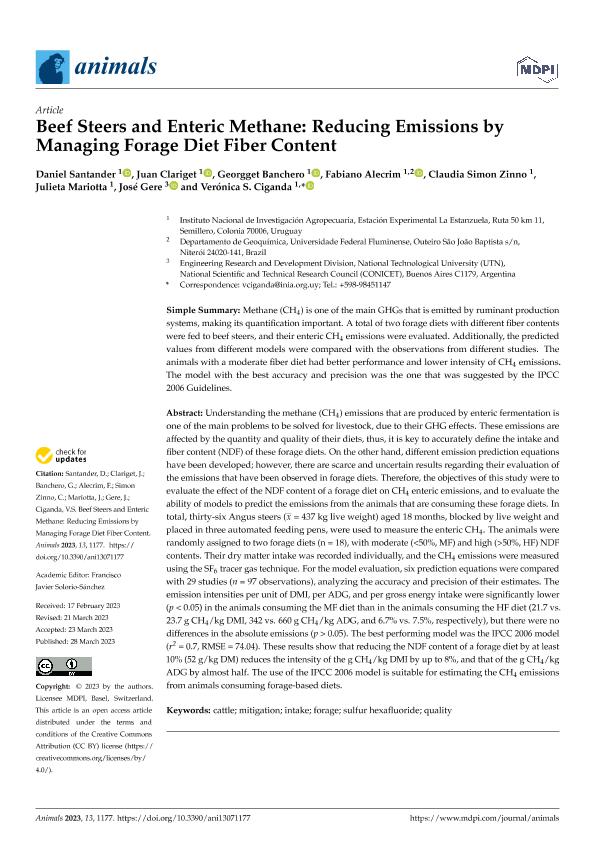Artículo
Beef Steers and Enteric Methane: Reducing Emissions by Managing Forage Diet Fiber Content
Santander, Daniel; Clariget, Juan; Banchero, Georgget; Alecrim, Fabiano; Simon Zinno, Claudia; Mariotta, Julieta; Gere, José Ignacio ; Ciganda, Verónica S.
; Ciganda, Verónica S.
 ; Ciganda, Verónica S.
; Ciganda, Verónica S.
Fecha de publicación:
03/2023
Editorial:
Multidisciplinary Digital Publishing Institute
Revista:
Animals
ISSN:
2076-2615
Idioma:
Inglés
Tipo de recurso:
Artículo publicado
Clasificación temática:
Resumen
Understanding the methane (CH4) emissions that are produced by enteric fermentation is one of the main problems to be solved for livestock, due to their GHG effects. These emissions are affected by the quantity and quality of their diets, thus, it is key to accurately define the intake and fiber content (NDF) of these forage diets. On the other hand, different emission prediction equations have been developed; however, there are scarce and uncertain results regarding their evaluation of the emissions that have been observed in forage diets. Therefore, the objectives of this study were to evaluate the effect of the NDF content of a forage diet on CH4 enteric emissions, and to evaluate the ability of models to predict the emissions from the animals that are consuming these forage diets. In total, thirty-six Angus steers ((Formula presented.) = 437 kg live weight) aged 18 months, blocked by live weight and placed in three automated feeding pens, were used to measure the enteric CH4. The animals were randomly assigned to two forage diets (n = 18), with moderate (<50%, MF) and high (>50%, HF) NDF contents. Their dry matter intake was recorded individually, and the CH4 emissions were measured using the SF6 tracer gas technique. For the model evaluation, six prediction equations were compared with 29 studies (n = 97 observations), analyzing the accuracy and precision of their estimates. The emission intensities per unit of DMI, per ADG, and per gross energy intake were significantly lower (p < 0.05) in the animals consuming the MF diet than in the animals consuming the HF diet (21.7 vs. 23.7 g CH4/kg DMI, 342 vs. 660 g CH4/kg ADG, and 6.7% vs. 7.5%, respectively), but there were no differences in the absolute emissions (p > 0.05). The best performing model was the IPCC 2006 model (r2 = 0.7, RMSE = 74.04). These results show that reducing the NDF content of a forage diet by at least 10% (52 g/kg DM) reduces the intensity of the g CH4/kg DMI by up to 8%, and that of the g CH4/kg ADG by almost half. The use of the IPCC 2006 model is suitable for estimating the CH4 emissions from animals consuming forage-based diets.
Palabras clave:
CATTLE
,
FORAGE
,
INTAKE
,
MITIGATION
,
QUALITY
,
SULFUR HEXAFLUORIDE
Archivos asociados
Licencia
Identificadores
Colecciones
Articulos(SEDE CENTRAL)
Articulos de SEDE CENTRAL
Articulos de SEDE CENTRAL
Citación
Santander, Daniel; Clariget, Juan; Banchero, Georgget; Alecrim, Fabiano; Simon Zinno, Claudia; et al.; Beef Steers and Enteric Methane: Reducing Emissions by Managing Forage Diet Fiber Content; Multidisciplinary Digital Publishing Institute; Animals; 13; 7; 3-2023; 1-18
Compartir
Altmétricas



